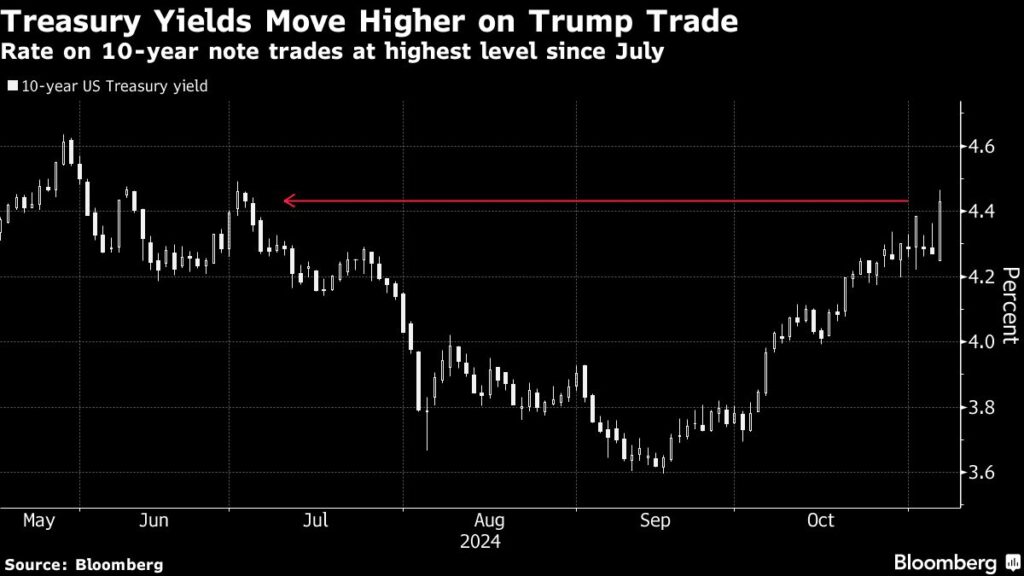In recent trading sessions, U.S. Treasury bonds, particularly the 30-year bond, have seen significant declines as investors react to the prospects of Donald Trump returning to the White House. The yield on the 30-year bond surged by 24 basis points, marking the largest single-day increase since the onset of the pandemic in March 2020. Simultaneously, other bonds on the curve also experienced upward pressure on yields as traders reassessed and reduced expectations for future interest rate cuts from the Federal Reserve. The yield on the two-year note climbed by as much as 13 basis points, indicating a shift in market sentiment and reflecting growing concerns about inflation and economic growth.
The current selloff in Treasuries is connected to what is referred to as the “Trump Trade,” where investors are doubling down on the anticipation that Trump’s potential return to the presidency will ignite inflationary pressures. The rising bond yields are seen as an endorsement of these strategies, as many believe Trump’s policies, including tax cuts and tariffs, will stimulate economic growth but at the cost of increased inflation. Analysts, such as Stephen Dover from Franklin Templeton, suggest that the bond market is pricing in expectations of stronger economic performance alongside heightened inflation, which may ultimately complicate the Federal Reserve’s ability to cut rates as previously calculated.
Since the yield on 10-year Treasuries rose to 4.48%, the highest since July, the divergence between U.S. and European bond yields has also become evident. Such behavior indicates underlying anxiety about the implications of U.S. tariffs on Europe’s export-dependent sectors, showing that while U.S. investors are preparing for a potential economic boom, their European counterparts are left wary of retaliatory measures and economic disruption. The inflation outlook has similarly affected the two-year inflation swap rates, which jumped to 2.62%—the highest level since April—reflecting renewed investor fears about rising prices.
Reflecting on historical parallels, some analysts note that the current bond market dynamics resemble the trends observed following Trump’s election in 2016, where inflation expectations surged in response to economic policies. Freya Beamish from TS Lombard noted that market participants are questioning whether the recent corrections in bond markets are merely preliminary shifts or indicative of a broader trend. The overarching sentiment is one of cautious optimism around Trump’s fiscal policies, charting a complicated path ahead as stakeholders navigate the economic landscape projected by a potential Trump administration.
The anxiety surrounding the selloff in U.S. Treasuries also stems from concerns about the budget deficit, which may escalate if Trump’s fiscal agenda is implemented. The increase in yield reflects apprehension about a potential rise in government bond supply, particularly with further long-dated auctions such as the upcoming 30-year sale. As yields climbed to 4.68%, those who participated in recent auctions are already facing significant losses, and the trading volume saw a marked uptick, demonstrating that investors are vigorously re-evaluating their strategies in light of these rapidly changing dynamics.
Despite the heightened trading activity and rising yields, some analysts caution against overreacting to the current economic scenario. There remains uncertainty regarding the outcome of the midterm elections and whether a divided Congress could hinder Trump’s ability to realize his fiscal policies. Investors like Mark Haefele from UBS suggest that while the market appears to be factoring in significant inflationary consequences of Trump’s potential return, there is still considerable unpredictability regarding implementation and actual economic impact. Thus, while trends in bond markets reflect immediate concerns around inflation and growth, the long-term trajectory remains uncertain and complex.

